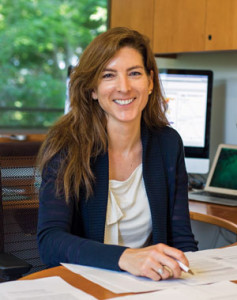Planning in the Near Term for Climate Change
By Georgette Jasen
When scientists talk about climate change, they usually mean significant changes in the measures of climate over several decades or longer. Climate variability generally refers to seasonal changes over a year or so.

Lisa Goddard, IRI Director
Lisa Goddard, an expert on climate change and variability, focuses on where the two intersect. As director of the Earth Institute’s International Research Institute for Climate and Society, based at Columbia’s Lamont campus, she looks into climate variations over a two-to-20 year time frame.
“The need to plan for longer time frames has become an issue,” says Goddard, also an adjunct associate professor in the Department of Earth and Environmental Sciences. “But very few of the decision makers we work with are thinking about the end of the 21st century or the next 50 years. They want to know if they will have water in their reservoirs for the next couple of years, or how to plan for agricultural evolution over the next 10 years.”
The institute Goddard leads works primarily with developing countries to help them anticipate and manage climate-related events such as droughts, floods and heat waves. Near-term climate change research, which addresses the next decade or two, can help governments plan infrastructure projects that take years to build, such as irrigation for crops that are normally rain-fed, or water-management policies for energy generation.
The IRI is one of more than a dozen Columbia research centers affiliated with the Earth Institute that focus on virtually every aspect of climate-related science. The Center for Climate Systems Research, for instance, brings together experts from Columbia and the NASA/Goddard Institute for Space Studies, who examine the earth’s climate sensitivity and variability and contributed to Mayor Michael Bloomberg’s sustainability plan for New York City. IRI’s research projects often involve collaborations with other Columbia schools, such as the Mailman School of Public Health and the School of International and Public Affairs.
Right now, Goddard and her colleagues are working with agriculture officials in Argentina, Brazil and Uruguay as well as farming consortiums to guide plans for soybean, maize and wheat crops over the next 10 to 20 years and determine whether irrigation will be necessary. It is funded by the National Science Foundation and the National Oceanic and Atmospheric Administration. IRI also works with NOAA’s Climate Prediction Center to help design tools and methods that can forecast the severity of droughts in the Colorado River basin in the U.S. and Mexico.
Continue reading Georgette Jasen’s profile of IRI’s Lisa Goddard on the Columbia Record’s website.
